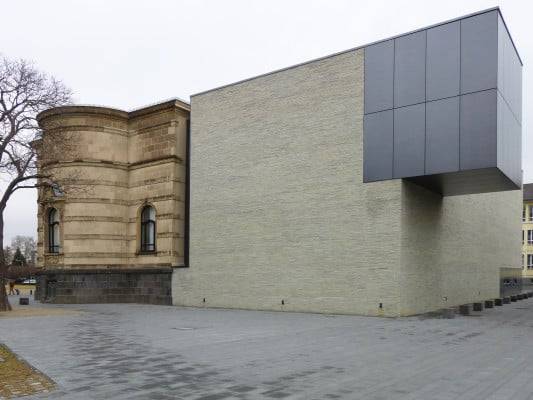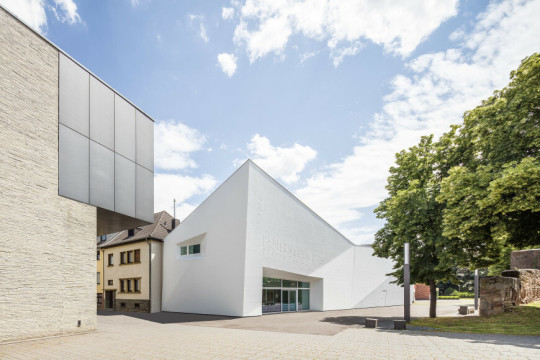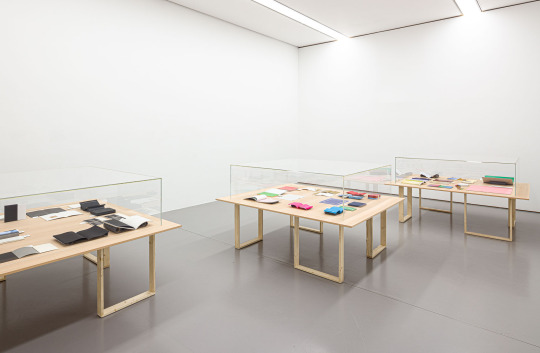#Leopold-Hoesch-museum
Photo

Leopold-Hoesch-Museum, Düren (Nov 2022)
NoltAfoto
29 notes
·
View notes
Text

Leopold-Hoesch-museum
0 notes
Text
Ich glaube komplett Düren wurde hier schon einmal als Sammelbegriff gepostet, aber ich würde gerne einmal spezifisch auf den Anbau des Leopold-Hoesch Museums hinweisen. Und auch direkt das Papiermuseum daneben, weil es auch so super in den Rest des Baukonzept der Dürener Innenstadt passt!
Von Vorne: Ah ein schönes altes Gebäude!

Von hinten: Was zur Hölle ist das?

Direkt daneben das Papiermuseum, natürlich in weiß.

50 notes
·
View notes
Text

Blank. Raw. Illegible... Artists' Books as Statements (1960-2022)
Leopold Hoesch Museum
7 notes
·
View notes
Text

Carl Hofer, Zwei Mädchen, 1938, Leopold Hoesch Museum Düren
2 notes
·
View notes
Photo

Anne Neukamp
Leopold-Hoesch-Museum, Düren 2023
Photo: Peter Hinschlaeger
0 notes
Text



Title by Author and Title / タイトル are currently on show at “Blank. Raw. Illegible... Artists’ Books as Statements (1960–2022)” at the Leopold-Hoesch-Museum in Düren, Germany until 3rd of September 2023.
With Blank. Raw. Illegible... Artists’ Books as Statements (1960–2022)" the Leopold-Hoesch-Museum shows a representative selection of international positions dedicated to the blank book as an artistic medium. The number of 259 artists’ books on display refers to the legendary exhibition Book as Artwork 1960/72 curated by Germano Celant and Lynda Morris, but the selection focuses exclusively on the qualities of blank, raw, illegible, empty, unprinted, tautological, hermetic, dysfunctional, and mysterious.
Curated by editor and collector Moritz Küng, the exhibition explores how contemporary artists and artist collectives exploit and activate the conceptual potential of a blank sheet of paper or a book with empty pages for their artistic practice. In the process, the empty, non-existent, and invisible become meaningful, and the refusal of legibility in the conventional sense becomes a telling statement. A seemingly absent content reveals a multitude of unexpected perspectives on conventions of communication and themes of speechlessness, origin, and disappearance. Starting with a significant exploration by artist Herman de Vries of the designation of the color white, the exhibition opens up the diversity of artistic concepts in reflecting on emptiness, purity, and raw material in relation to the formal and functional criteria of books in 15 chapters, the headings of each of which are taken from one of their book titles.
The exhibition is accompanied by a comprehensive catalog published by Buchhandlung König and Franz König, Köln, with details of the works, references and illustrations of all the books exhibited.
Photos by Peter Hinschläger
0 notes
Text
instagram
aa
Amb "Blank. Raw. Illegible... Artists' Books as Statements (1960-2022)" el Leopold-Hoesch-Museum mostra una selecció representativa de posicions internacionals dedicades al llibre en blanc com a mitjà artístic. El nombre de 259 llibres d'artista exposats, entre d'altres de Michael Asher, Luciano Bartolini, Irma Blank, Marcel Broodthaers, Ulises Carrión, Olafur Eliasson, Ryan Gander, Dora Garcia, Martin Kippenberger, Sara MacKillop, Piero Manzoni, Bruce Nauman, Olaf Nicolai, Ed Ruscha, Simon Starling i Heimo Zobernig es refereixen a la llegendària exposició "Book as Artwork 1960/72" comissariada per Germano Celant i Lynda Morris, però la selecció se centra exclusivament en les qualitats de blanc, cru, il·legible, buit, sense imprimir. , tautològic, hermètic, disfuncional i misteriós.
Comissariada pel comissari, editor i col·leccionista Moritz Küng, l'exposició explora com els artistes i col·lectius d'artistes contemporanis exploten i activen el potencial conceptual d'un full de paper en blanc o un llibre amb pàgines buides per a la seva pràctica artística. En el procés, el buit, l'inexistent i l'invisible esdevenen significatius, i el rebuig a la llegibilitat en el sentit convencional esdevé una afirmació il·lustradora. Un contingut aparentment absent revela multitud de perspectives inesperades sobre les convencions de comunicació i els temes de la mudança, l'origen i la desaparició. A partir d'una important exploració de l'artista Herman de Vries de la designació del color blanc, l'exposició obre la diversitat de conceptes artístics en reflexionar sobre el buit, la puresa,
1 note
·
View note
Text
Noch keine Critical Mass Düren
Noch keine Critical Mass Düren
gab es am gestrigen zweiten Maifreitag. Zwar waren zwei Menschen zum Marktplatz gekommen und anschließend noch zwei zusätzlich zum Leopold-Hoesch-Museum.
Aber natürlich spielte sich alles mit viel Abstand ab und das Trüppchen löste sich auch sofort wieder auf.
Ich selber hatte die Gelegenheit, mich mal wieder auf CMCGN Feeling zu kriegen, sowieso nur als Rennrad-Einzelfahrt geplant und auch…

View On WordPress
#cmdn#Marktplatz#Bernhard Gaul#critical mass düren#GPX-Viewer/Fotoversion OSM 3.6#Leopold-Hoesch-Museum
0 notes
Photo

“Still Life with Grapes, Peaches, A Pear And Nuts/Stillleben mit Weintrauben, Pfirsichen, einer Birne und Nüssen”, 1869, Emilie Preyer (German painter, 1849-1930).
~ Emilie Preyer, who was painting in the Düsseldorf School style, continued the traditional still life painting of her father, Johann Wilhelm Preyer at a high level painting technique in Dusseldorf. Under the guidance and example of her father, she had completed her private training as a painter in a hurry. Since women were not admitted to universities everywhere, she was then after her father's training as an unofficial student of the Düsseldorf Royal Academy of Art. She had, among other exhibitions in Berlin, Dresden and her hometown. Her studio was in her father's house on Garden Street 33.Her early still life paintings, circa 1866/1867, still have small picturesque weaknesses, who disappeared two years later. Although Emilie's flower and fruit still differ life in choice of subject and composition by the paintings of her father, there are still differences. In the still lifes of fruits represented by the daughter effect picturesque softer side of the incident light emphasizes the volume of the objects a little less, the arrangements are often draped on tablecloths, while the father used almost exclusively marble as a base. In the international recognition Emilie drew on the reputation of her father. The New York Metropolitan Museum and the Picture Gallery in Philadelphia acquired Still Life of Preyer-daughter. Emilie Preyer's works are also in English and American private collections. There should even today the majority of the 250 paintings are, painted by Emilie Preyer. A fruit still life on marble plate is one of the exhibits in the Düren Leopold Hoesch Museum. The little work shows grapes, a peach, plums and a fly. ~
2 notes
·
View notes
Text

Leopold-Hoesch-Museum, Düren (März 2024)
NoltAfoto
11 notes
·
View notes
Text
Art in the Time of Terror · Schirn Kunsthalle Frankfurt

Art in the Time of Terror · Schirn Kunsthalle Frankfurt
Ernst Wilhelm Nay - Woman head resting on a hand - 1944Hannah Hoch - 1945 The End
From 4 March to 6 June 2022, the Schirn Kunsthalle Frankfurt presents "Art For No One", an exhibition focusing on the artists who remained in Germany between 1933 and 1945, under the control of the National Socialist regime.
Images: Ernst Wilhelm Nay, "Woman's head resting on a hand", 1944, Gouache on paper, 15.4 x 23.7 cm, Leopold-Hoesch-Museum & Papiermuseum Düren, © Photograph: Peter Hinschläger. Fotografie Ernst Wilhelm Nay Stiftung / VG Bild-Kunst, Bonn 2021 ·· Hannah Höch, "1945 (The End)", 1945, oil on canvas, 92,8x81,4 cm, Berliner Sparkasse © VG Bild-Kunst, Bonn 2021
In the years leading up to the outbreak of the Second World War, the growing climate of fear led an increasing number of artists to leave Europe and seek refuge in calmer lands. The situation was particularly threatening for German artists, who were forced to live under the National Socialist regime, which caused a good number of them -Max Beckmann and George Grosz, for example- to leave Germany and end up spending the last part of their careers in the United States.
Despite this mass exile, not a few artists remained in Germany, and -showing no affiliation with or sympathy for the National Socialist regime- suffered to a greater or lesser extent from the reprisals. The exhibition at the Schirn includes some 150 works (paintings, sculptures, drawings and photographs) by 14 different artists. Among them, perhaps the most notable case is Otto Dix (1891-1969), who had already suffered first-hand from the effects of World War I ("the work of the devil!" as he wrote in his war diary), and whose two great masterpieces -The Trench and War Cripples- were included by the Nazi regime in the exhibition Entartete Kunst (Degenerate Art) and subsequently destroyed.
Other artists included in the exhibition (which, according to the Schirn Kunsthalle in a press release, does not follow a uniform stylistic development, but focuses on the contradictory nature of this period) are Ernst Wilhelm Nay, Hannah Höch, Willi Baumeister, Hans Grundig, Lea Grundig, Werner Heldt, Marta Hoepffner, Karl Hofer, Edmund Kesting, Hans Uhlmann, Fritz Winter, Jeanne Mammen and Franz Radziwill.
Read the full article
1 note
·
View note
Photo

Otto Dix (German, 1891-1969), Selbstbildnis mit Staffelei [Self-Portrait with Easel], 1926. Tempera on wood, 80 x 55 cm. Leopold-Hoesch-Museum & Papiermuseum, Düren
242 notes
·
View notes
Text

Rembrandt van Rijn, Selbstbildnis mit Saskia, 1636, Leopold-Hoesch-Museum Düren
0 notes
Photo

Heute haben wir einen kleinen Ausflug ins Papiermuseum Düren gemacht. Hier erfahrt ihr alles über die Geschichte des Papieres und habt sonntags auch die Möglichkeit selbst Papier zu schöpfen, inklusive Wasserzeichen. Jetzt weiß ich ein bisschen besser darüber Bescheid, auf welchem Material ich täglich zeichne und meine Motive drucken lasse :) . . . . #papiermuseum #düren #nrw #museum (hier: Leopold-Hoesch-Museum & Papiermuseum Düren) https://www.instagram.com/p/BvZx2ShnYUy/?utm_source=ig_tumblr_share&igshid=tzmlopggjxsm
0 notes
Link
Artist: Sam Lewitt
Venue: Miguel Abreu, New York
Exhibition Title: DREAMBOAT DIRTBLOCK
Date: January 16 – February 23, 2020
Click here to view slideshow
Full gallery of images, press release and link available after the jump.
Images:
Images courtesy of Miguel Abreu, New York
Press Release:
Why do [those] in the middle of the boat move the boat the most? Is it because the oar is a lever?
– Archytas of Tarentum
Cover the champagne glasses. They’ll swell to shattering. A toast – to a streamlined luxury liner that will never exist.
Dirt block is your hard cure for lack of supply.
The lever is a stick plus will. No bubbles here. Pressure expels excess air.
Brick fits your hand.
Disappointment follows relief. The portal cracked to soft focus lenses. It’s all stagecraft.
You know this.
Pleasure follows disappointment. Unfulfilled projects look better in the pictures. It’s never enough.
DREAMBOAT DIRTBLOCK is made between a lever and lens. Compressed blocks of soil extracted from NYC building foundation pits, curing to maximum hardness throughout the duration of the exhibition sit next to fragmented images of a boat, itself a toppled skyscraper.
This unrealized design for a streamlined cruise ship from the early 20th century is the result of an office exercise commissioned by Norman Bel Geddes design associates. The boat was shaped to optimally reduce friction with external environmental conditions. In this exhibition it appears through the effluence of its internal combustion. The drift of multiple fires has been simulated in a digital model of its hull using software designed to test fluid dynamics.
LENS crystallizes snapshots of this ‘smoke test’ into light shaping surfaces. Milled shards of a shattered Plexiglas sheet filter the light from a single LED: gathering it into an image through sheer surface variation. These projections are physically identical to rippled patterns refracted onto surfaces adjacent to water on a sunny day. The computational reconstruction and control of this phenomenon is being developed as a method of optical watermarking. While the movement of water and light are technically the guiding principle, in optics this phenomenon is referred to as a “caustic” projection, a word whose original meaning is “to burn.”
LEVER produces more terrestrial projectiles: interlocking blocks of compacted subsoil dug up for the project of stabilizing air rights over terra firma. These compressed earth blocks are made with a manual earth-ramming machine, whose mobility within resource scarce contexts enables the direct use of local soil for shelter and road construction.
This press is a descendent of the so-called CINVA-RAM designed in the 1950s by Chilean engineer Paul Ramirez. It is historically associated as much with the ambiguous history of “self-help” housing in the developing world throughout the 20th century as it is with practitioners of small-scale ecological self-sufficiency. It is portable, yet totally bound to a simple metabolism of production with the ground on which it sits. Dreams of frictionless transport are grounded in relations negotiated on site.
DREAMBOAT (Model Views) presents further fragments of the boat model rotating through various perspectives. These views result from the resistance of oil, acid and water to one another. The craft’s shell is etched by these clashing fluids on the surface of copper-clad plastic, a material support that is engineered to control friction and passage in the circulation of information.
Sam Lewitt was born in Los Angeles in 1981. He completed the Whitney Independent Study Program in 2005 after receiving his BFA from the School of Visual Arts in 2004. In 2017, his work was on view in ARTE VIVA ARTE, the 57th International Art Exhibition, Venice Biennale. Lewitt’s exhibition More Heat Than Light opened in September 2015 at the CCA Wattis Institute in San Francisco, before then traveling in 2016 to the Kunsthalle Basel, and finally, under the title Less Light Warm Words, to the Swiss Institute in New York. Previously, Lewitt co- organized the exhibition and Materials and Money and Crisis at the MUMOK (Vienna) with Richard Birkett, a show in which he was also included, and drunken walks/cliché/corrosion fatigue/ebay at Miguel Abreu Gallery. His work “Fluid Employment” was exhibited in the 2012 Whitney Biennial. Solo exhibitions dedicated to Lewitt’s work have been held at Miguel Abreu Gallery (2018, 2014, 2011, 2008, 2006), Galerie Buchholz, Berlin and Cologne (2017, 2013, 2011, 2008), Leopold-Hoesch-Museum, Düren (2014), and Galleria Franco Soffiantino, Turin (2009, 2007). His work has also appeared in exhibitions at the Musée d’Art Moderne de la Ville de Paris, the Museum of Modern Art, Bergen Kunsthall, Secession, La Panacée, The Brno House of Arts, the Pulitzer Foundation, Fridericianum, David Roberts Art Foundation, White Columns, SculptureCenter, MoMA PS1, Artists Space, the Swiss Institute, David Zwirner, Elizabeth Dee Gallery, and Andrew Roth Gallery. His work is held in the collection of the Whitney Museum of American Art, the Museum of Modern Art, New York, the San Francisco Museum of Modern Art, MUMOK, Vienna, the Centre Georges Pompidou, Paris, and the Fondation d’Entreprise Galeries Lafayette, Paris, among others. Lewitt was the recipient of the 2018 BMW Open Work commission at the Frieze Art Fair in London, a 2018 Grants to Artists award from the Foundation for Contemporary Arts, and was also the 2018 Teiger Mentor in the Arts at Cornell University. Lewitt will have a solo exhibition at Z33 – House for Contemporary Art in Hasselt, Belgium in June 2020.
Link: Sam Lewitt at Miguel Abreu
Contemporary Art Daily is produced by Contemporary Art Group, a not-for-profit organization. We rely on our audience to help fund the publication of exhibitions that show up in this RSS feed. Please consider supporting us by making a donation today.
from Contemporary Art Daily http://bit.ly/37qYCgz
0 notes